Carnival in Sardinia

the secluded mountain region of Barbagia, which is culturally a kind of island in the island. And there, primarily in the village of Mamoiada.
 Mamoiada is one of the oldest settlements in Sardinia. Next to it, in the double cave Sa Oche e Su Ventu was excavated one of the island’s oldest – twenty thousand years old – human habitation, and the huge rock-cut tombs under the village have been in use since the 6th millennium BC. In the Middle Ages, the remote and inaccessible mountain region could not be really achieved by the Catholic Church: in contrast to the rest of Sardinia, no monastic community has settled next to the village, and its only church was the small shepherd church of St. Cosmas and Damian, far from the settlement. This may also explain the survival of those very ancient carnival and spring-greeting fertility rites, which thousands of years ago were common throughout the Mediterranean, but today their remains are to be found mainly in the mountain villages of the Balkans.
Mamoiada is one of the oldest settlements in Sardinia. Next to it, in the double cave Sa Oche e Su Ventu was excavated one of the island’s oldest – twenty thousand years old – human habitation, and the huge rock-cut tombs under the village have been in use since the 6th millennium BC. In the Middle Ages, the remote and inaccessible mountain region could not be really achieved by the Catholic Church: in contrast to the rest of Sardinia, no monastic community has settled next to the village, and its only church was the small shepherd church of St. Cosmas and Damian, far from the settlement. This may also explain the survival of those very ancient carnival and spring-greeting fertility rites, which thousands of years ago were common throughout the Mediterranean, but today their remains are to be found mainly in the mountain villages of the Balkans.
The Carnival of Mamoiada begins on the night of 16 January, the feast of St. Anthony, when fires are lit and masquerade processions organized across the whole Mediterranean. The two types of the Mamoiada processions are the mamuthones and the issohadores. The former, who symbolize some kind of ancient animal or natural force, wear black sheep skin dress, black wooden mask and black cloth, and carry on their back twenty to thirty kilos of copper bells – “sa carriga” – with bone tongues, which accompany with a ghostly roar their slow, rhythmic procession. The latter follow them in red-white Renaissance – or as they say here, “Turkish” – dress, mostly in white masks, with lasso in the hand, with which they try to pull the viewers into the march. The procession ends at the bonfire lit on the main square of the town, where all the participants and spectators are offered a traditional Sardinian plate of beans with bacon, and the whole village is united in a Sardinian round dance – ballu tundu – around the fire.
Today we travel to the Carnival. Now we can illustrate this short report only with the pictures of the booklet of the Mask Museum of Mamoiada. On the evening of Shrove Tuesday we can hopefully publish our own photos on the feast.
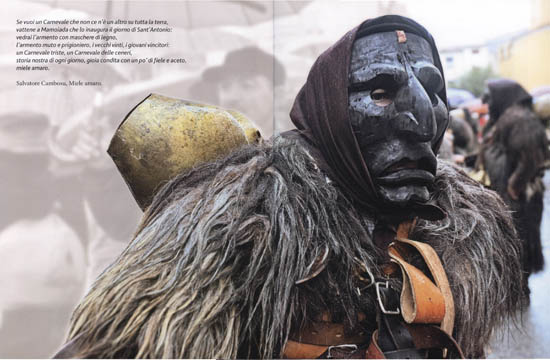
Tenores di Bitti: Ballate a ballu tundu (Round dance). From the album Ammentos (1996)


in English
Start point
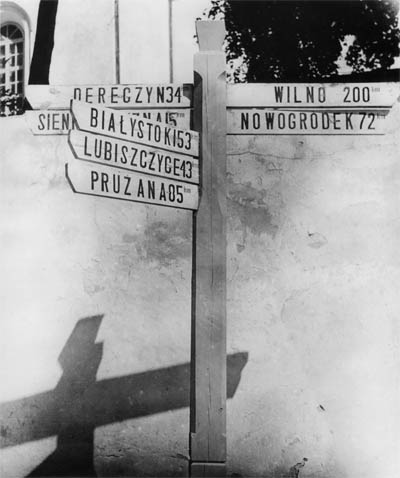

 Yes, you have guessed well. The signpost stood in today’s Belorussian town of Слоним, at a time when, between the two world wars, it belonged to Poland as Słonim. Vishniac published the photo with the title “From Słonim the roads lead to everywhere in the world”. The version found in the Vishniac Archive shows that the signpost stood behind the great synagogue, built in 1642, lending a special connotation to the title. Słonim, established at the confluence of the navigable Shchara and Issa rivers, has been an important trading town since the Middle Ages, with a Jewish quarter known since 1388, and with a pre-war Jewish population of nearly 20 thousand. Its beautiful great synagogue was even spared the devastation of the war. Hence comes the Słonim Hasidic Dynasty in Israel, and the founder of the British Marks & Spencer warehouse chain. Vishniac visited the town between 1935 and 1938, during his photographic survey of the Eastern European Jewish settlements. Let us include here the other photos he took in Słonim, too, as well as two closing pictures on the weekly market and the firemen of Słonim. The latter is a part of a postcard series of ethnographic interest, which was published on the town, and primarily on its exotic-looking Jews in 1917, during the German military occupation. The other pieces of the series can be seen on Pinterest’s Słonim page and in Eliat Gordin Levitan’s collection of old Słonim photos, and a superb stand-alone piece here.
Yes, you have guessed well. The signpost stood in today’s Belorussian town of Слоним, at a time when, between the two world wars, it belonged to Poland as Słonim. Vishniac published the photo with the title “From Słonim the roads lead to everywhere in the world”. The version found in the Vishniac Archive shows that the signpost stood behind the great synagogue, built in 1642, lending a special connotation to the title. Słonim, established at the confluence of the navigable Shchara and Issa rivers, has been an important trading town since the Middle Ages, with a Jewish quarter known since 1388, and with a pre-war Jewish population of nearly 20 thousand. Its beautiful great synagogue was even spared the devastation of the war. Hence comes the Słonim Hasidic Dynasty in Israel, and the founder of the British Marks & Spencer warehouse chain. Vishniac visited the town between 1935 and 1938, during his photographic survey of the Eastern European Jewish settlements. Let us include here the other photos he took in Słonim, too, as well as two closing pictures on the weekly market and the firemen of Słonim. The latter is a part of a postcard series of ethnographic interest, which was published on the town, and primarily on its exotic-looking Jews in 1917, during the German military occupation. The other pieces of the series can be seen on Pinterest’s Słonim page and in Eliat Gordin Levitan’s collection of old Słonim photos, and a superb stand-alone piece here.


Dissolving: The saddle
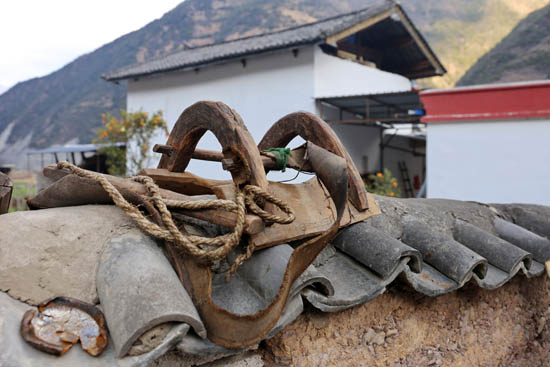
 What kind of saddle is this on the fence, in the Lisu-Tibetan village of Cizhong/Cedro? If you asked me on the spot, I certainly would have guessed horse or mule.
What kind of saddle is this on the fence, in the Lisu-Tibetan village of Cizhong/Cedro? If you asked me on the spot, I certainly would have guessed horse or mule.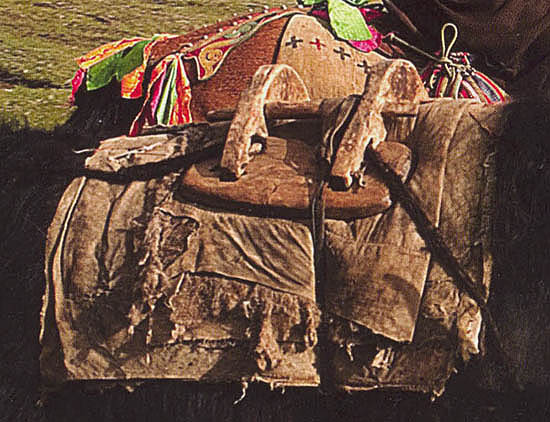
But ever since I saw this photo, taken by Michael Yamashita not far from here, and published in his photo album on the tea-horse-road Shangri-La. Par la route du thé et des chevaux (2012), I cannot look at it without seeing, instead of the curved spine of the tile-roofed fence, the backbone of the yak.
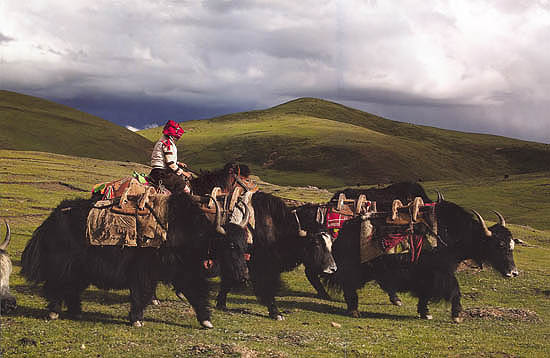
magyarul
Beneath the Jade Dragon

 Lumu’s Tibetan House is a source of knowledge for the initiated in Lijiang. Unlike with the Chinese, most of whom do not even know what’s in their own neighborhood, here you can get up to date information about accommodations in the surrounding towns, highly recommended, but not available on the Internet, guest houses and restaurants operated by Tibetans, detailed hand-drawn maps of the paths of the 2,500-meter-deep Tiger Leap Gorge, and a photocopied bicycle map of the old town of Lijiang, which indicates the places where bikes can be rented. This is important knowledge, because the rental business is located at the edge of the large old town, beneath a modern block of flats, opposite the statue of Mao, where only hardcore leftists of the sixties would pilgrimage otherwise. The bike rental is 30 yuan, or 4 euros, for a day, with a 250 yuan or 36 euros deposit. Our goal is the string of little towns of the Naxi ethnic group to the north of Lijiang, beneath the Yulong Mountain: Shuhe, Baisha, Yuhu.
Lumu’s Tibetan House is a source of knowledge for the initiated in Lijiang. Unlike with the Chinese, most of whom do not even know what’s in their own neighborhood, here you can get up to date information about accommodations in the surrounding towns, highly recommended, but not available on the Internet, guest houses and restaurants operated by Tibetans, detailed hand-drawn maps of the paths of the 2,500-meter-deep Tiger Leap Gorge, and a photocopied bicycle map of the old town of Lijiang, which indicates the places where bikes can be rented. This is important knowledge, because the rental business is located at the edge of the large old town, beneath a modern block of flats, opposite the statue of Mao, where only hardcore leftists of the sixties would pilgrimage otherwise. The bike rental is 30 yuan, or 4 euros, for a day, with a 250 yuan or 36 euros deposit. Our goal is the string of little towns of the Naxi ethnic group to the north of Lijiang, beneath the Yulong Mountain: Shuhe, Baisha, Yuhu.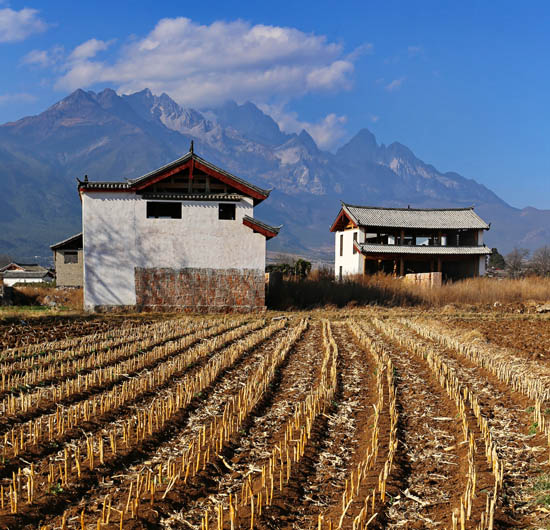

 The Yulong Mountain, as befits its name, hovers above the plain like an enormous dragon carved with jagged contours out of a single piece of jade. I stop to take a photo. So that the electrical line that goes alongside the road does not cut the dragon at the waist, I walk a bit ahead into the abandoned rice field, where a thorny weed rips a large hole on my pants. No matter, Baisha is the center of traditional Naxi embroidery, so I hope to find a master who can repair it with a sewing machine.
The Yulong Mountain, as befits its name, hovers above the plain like an enormous dragon carved with jagged contours out of a single piece of jade. I stop to take a photo. So that the electrical line that goes alongside the road does not cut the dragon at the waist, I walk a bit ahead into the abandoned rice field, where a thorny weed rips a large hole on my pants. No matter, Baisha is the center of traditional Naxi embroidery, so I hope to find a master who can repair it with a sewing machine.
An old paved street turns off the main road towards the center of the town. The old houses along it are being beautifully restored, the new ones are being provided with old-style porches and gates, in the spirit of the new times.
 In front of a grocery store, an old woman is washing vegetables in the stream. “Where can I find someone in the village, who could sew my pants?” “We’ll do it for you!”, she replies. She examines them, then she brings out a thread of matching color, threaded in a needle. She calls out the seller from the store. She looks at my legs, to find the best place to start the work, so I helpfully take off my pants. She turns away, with an embarrassed scream and giggles. While she is sewing in front of the shop, I am talking to the old man sitting at the old mahjong table: the grocery store is also a kind of a daycare home for elderly people. The pants are soon done, its value as handmade Naxi embroidery has increased significantly. “How much does the work cost?” I ask. “Nothing”, she says, surprised, and does not accept money even when I insist many times.
In front of a grocery store, an old woman is washing vegetables in the stream. “Where can I find someone in the village, who could sew my pants?” “We’ll do it for you!”, she replies. She examines them, then she brings out a thread of matching color, threaded in a needle. She calls out the seller from the store. She looks at my legs, to find the best place to start the work, so I helpfully take off my pants. She turns away, with an embarrassed scream and giggles. While she is sewing in front of the shop, I am talking to the old man sitting at the old mahjong table: the grocery store is also a kind of a daycare home for elderly people. The pants are soon done, its value as handmade Naxi embroidery has increased significantly. “How much does the work cost?” I ask. “Nothing”, she says, surprised, and does not accept money even when I insist many times.
 “Where is the old town?” I ask. “That way”, she points further on the paved street, “but it’s very small”, and she shows with the hand, how small. The old town is in fact small, but very cozy. The town gate immediately opens onto the main square, flanked by good eateries. In the shade of a big tree, old greengrocer women and men gather for a conversation dressed in traditional Naxi attire. We lock our bikes to the town gate, sit down in the open door of one of the canteens, order beer, we get acquainted with the drama taking place on the stage of the main square and its actors.
“Where is the old town?” I ask. “That way”, she points further on the paved street, “but it’s very small”, and she shows with the hand, how small. The old town is in fact small, but very cozy. The town gate immediately opens onto the main square, flanked by good eateries. In the shade of a big tree, old greengrocer women and men gather for a conversation dressed in traditional Naxi attire. We lock our bikes to the town gate, sit down in the open door of one of the canteens, order beer, we get acquainted with the drama taking place on the stage of the main square and its actors.
Three streets begin at the southern city gate, each one has its own profile. Along the one going straight ahead to the north, they sell embroidered and batik clothes in the old courtyards, both old and new, equally beautiful. Here you can also consult Doctor He Shixiu, the eighty-year-old miracle doctor, a local celebrity, to whom they come from far and wide for healing. In front of his house, a collection of newspaper clippings evidence his fame. The street going east, toward the mountains, is flanked by peasant houses, it heads out to the rice fields. The plum trees are already blossoming in the fields, though it’s only February, and in the background, like the Fuji, floats Mount Yulong. The oriental postcard comes home.

The street leading west, to the medieval Dabaoji Temple, is the main street of the town. It is flanked by small antique shops, tea houses, convenience stores. In one of them, a mahjong battle rages on, to the death, just as dominoes are played in Georgia. Some ten men are competing with a woman, the shopkeeper. The clicks of mahjong tiles emphatically striking the table, and the guttural sounds of short commentaries. They are aware of our presence, but they do not look up, they do not break away from the game.

 In the middle of the street, an open pavilion. Old musicians are giving a concert on a weekday afternoon. Donations are welcome, but according to the tatsepao put out in front of the pavilion, their true purpose is the revival of the traditional Naxi music. This music, which has a thousand-year-old tradition, flourished before the Cultural Revolution, with several ensembles playing in every town. Its oldest version was called precisely “Baisha music” (白沙细乐, Báishā xìyuè), because it took shape and was preserved here, in the capital of the former Naxi kingdom, independent until 1271. Mao, however, banned traditional music across the country, and had the instruments broken. Most of the old musicians educated in the tradition have since died, and with them also a part of the repertoire. The survivors now try to pass on their knowledge, while they still can.
In the middle of the street, an open pavilion. Old musicians are giving a concert on a weekday afternoon. Donations are welcome, but according to the tatsepao put out in front of the pavilion, their true purpose is the revival of the traditional Naxi music. This music, which has a thousand-year-old tradition, flourished before the Cultural Revolution, with several ensembles playing in every town. Its oldest version was called precisely “Baisha music” (白沙细乐, Báishā xìyuè), because it took shape and was preserved here, in the capital of the former Naxi kingdom, independent until 1271. Mao, however, banned traditional music across the country, and had the instruments broken. Most of the old musicians educated in the tradition have since died, and with them also a part of the repertoire. The survivors now try to pass on their knowledge, while they still can.Naxi musicians, Baisha. Record by Lloyd Dunn, February 2017

magyarul
Domingo por la mañana

 Esto podría ocurrir en cualquier iglesia de pueblo de Transilvania cualquier domingo por la mañana. Sin embargo, estamos en el Tíbet histórico, entre montañas de seis mil metros de altura, sobre el curso del río Mekong, en la ciudad de Cizhong (茨中), en el Cedro tibetano (ཊསེ་ཌྲོ). El traje tradicional es azul y rojo, con un turbante rojo para las mujeres y un abrigo de piel de yac y sombrero de ala ancha para los hombres, que no se quitan ni en la iglesia. Hablan en el dialecto tibetano lisu. El texto de los oficios diivinos se entona con la melodía de los sutras budistas tibetanos. El sacerdote es chino.
Esto podría ocurrir en cualquier iglesia de pueblo de Transilvania cualquier domingo por la mañana. Sin embargo, estamos en el Tíbet histórico, entre montañas de seis mil metros de altura, sobre el curso del río Mekong, en la ciudad de Cizhong (茨中), en el Cedro tibetano (ཊསེ་ཌྲོ). El traje tradicional es azul y rojo, con un turbante rojo para las mujeres y un abrigo de piel de yac y sombrero de ala ancha para los hombres, que no se quitan ni en la iglesia. Hablan en el dialecto tibetano lisu. El texto de los oficios diivinos se entona con la melodía de los sutras budistas tibetanos. El sacerdote es chino.Campanas y cantos tibetanos en Cizhong. Grabación de Lloyd Dunn, febrero de 2017

La primera parroquia católica del valle la consagraron, en 1867, los padres de la Société des Missions Étrangères de París. Su fundador, el padre Charles Renou, pasó dos años en el monasterio lama de Dongzhulin, disfrazado de comerciante chino, para aprender el idioma antes de comenzar su misión tibetana. La comunidad creció rápidamente, pronto abrazó todo el valle y una segunda iglesia se erigió al sur, en la ciudad de Cigu. En 1904, durante la ocupación británica del Tíbet, los rebeldes tibetanos mataron a todos los europeos, incluidos los monjes franceses, pero la orden pronto enviaría nuevos misioneros. El siguiente golpe lo recibió la comunidad en 1952, cuando el gobierno comunista chino prohibió la religión cristiana, desterró a sus líderes extranjeros y encarceló o mató a los chinos. Los católicos de Cizhong, al igual que otros miles de diversas comunidades cristianas chinas, pasaron a la clandestinidad para celebrar sus reuniones en secreto, en casas particulares, durante treinta años. La prohibición comenzó a relajarse en los años ochenta. En 1982, los fieles recuperaron la iglesia que durante todos esos años se utilizó como escuela primaria. En 1990 la restauraron.
El techo de estilo románico, reconstruido después de la devastación de 1905, se parece más ahora a los templos chinos. Las paredes están decoradas con flores de loto chinas y los plafones de la cubierta con motivos tibetanos. Sólo los frescos de los pasillos, con escenas de la vida de Cristo, fueron destrozados durante la Revolución Cultural. En el altar mayor, un Cristo, y en los dos laterales San José y María, cada uno flanqueado por dos cintas rojas, con filacterias chinas en letras de oro. Dos bandas rojas similares lucen también a la puerta del atrio de la iglesia, al parecer colocadas hace poco, para la fiesta de enero de los Reyes Magos: 一 星 从 空 显示, 三 王 不 约 偕 来 yī xīng cóng kōng xiǎnshì, sān wáng bù yuē xié lái, «una estrella surgió de la nada, tres reyes se juntaron para admirarla». Como si nos estuviera hablando a nosotros, que, habiendo tenido conocimiento de esta extraña estrella, hemos venido a verla desde el lejano Occidente


Hace tres días que salimos de Lijiang, la ciudad central del norte de Yunnan, siguiendo el curso alto del Yangtsé a través de las majestuosas cadenas de montañas de Hengduan y los pasos fronterizos tibetanos, siguiendo la Ruta del Caballo y del Té por la Meseta de Gyalthang. Aquí estaban los antiguos pastos de los reyes tibetanos, donde las caravanas de té podían sentir que habían superado la peor parte del viaje. También nosotros descansamos aquí por primera vez, en la ciudad de Zhongdian, recientemente rebautizada por el gobierno chino como la mítica Shangri-La para promover el turismo interior. A continuación, otro viaje en autobús de cuatro horas serpenteando por las escarpaduras hasta la ciudad de Deqin, en cuyo dominio las diez cimas blancas de nieve de la cordillera de Meili brillan tornasoladas al atardecer y al amanecer. Desde aquí no hay transporte público, hay que alquilar un taxi siguiendo ritualmente una negociación bien coreografiada, en chino, durante la cual hay que salir del coche airadamente, agarrando el equipaje y sacudiendo la cabeza con indignación, hasta que el conductor mismo te siga por la calle principal proponiendo un precio al fin razonable. El precio razonable es de cuatrocientos yuanes para dos –unos 50 euros–, ida el sábado por la tarde y vuelta el domingo por la tarde al valle de Cizhong, que se encuentra a setenta kilómetros al sur a lo largo del Mekong.

A medida que nos acercamos a la iglesia, los campos de arroz en la vega del río se sustituyen por un espectáculo muy inusual aquí, bajo los Himalayas: viñedo. Las uvas fueron plantadas por los padres franceses y echaron raíces en el valle, protegidas del norte, y se extendieron al sur. Su producto es entregado hoy a la bodega de un comerciante de Hong Kong. Lo encontramos ya en Shaxi como «el vino de los monjes», y se vende en muchos lugares del pueblo.

Al norte, donde se abre el valle del Mekong, todavía podemos ver las cumbres de las montañas de Meili. Caminamos hacia la iglesia entre casas de madera tibetanas, cobertizos, puertas talladas. En algunas aparece una cruz entre los dragones. Calabash se revuelve entre naranjos muy productivos. Las ancianas de turbante rojo nos devuelven el saludo, nos invitan a comer. Los niños se esconden detrás de las puertas ante la visión de estos demonios de nariz larga. El convento, en su momento fundado para albergar monjas tibetanas enfermeras y maestras, fue más tarde una escuela y ahora está abandonado. Pero la iglesia ha sido muy bien restaurada. El sacerdote chino, que vino de Mongolia Interior, un hombre menudo y sin edad definible, pasea por el cementerio rezando el rosario. –¿A qué hora es la misa de mañana? –A las diez.

Los fieles llegan a las nueve y media, se reúnen en los escalones de la iglesia. Todos entregan algún billete al sacristán o conserje que está sentado a la puerta. Para el mantenimiento de la iglesia, cinco yuanes, diez yuanes. En euros, de uno a uno y medio. La joven sentada a su lado registra cuidadosamente el nombre de cada donante y la cantidad en un cuadernillo. Un hombre de rostro serio llega con una bolsa grande de cartero, despega los anuncios rojos de la semana anterior que lucen en el interior de la puerta y coloca encima los nuevos. Hay muchos niños, la mayoría cargados a la espalda, otros dos o tres van de la mano: la ley china de un hijo no se aplica a los pueblos minoritarios. Los niños reciben la mayor atención en la iglesia. Se los pasan de mano en mano y son libres de correr y jugar en la parte posterior del templo.

Sólo han pasado unos años desde que el pueblo tiene de nuevo sacerdote. Respeta la ceremonia laica que arraigó en el último medio siglo. Así, la misa dominical prácticamente se duplica. De diez a once, los fieles rezan tal y como hicieron durante los sesenta años pasados sin sacerdote. Cantan el oficio en su lengua materna. Es el momento en que cada uno diga lo que considere importante para la comunidad. El cartero de rostro serio explica en tibetano los anuncios en chino que acaba de colocar en la puerta. La joven de la colecta también se levanta y lee de su cuadernillo cuántos han dado algo por la iglesia. A la entrada de los «huéspedes extranjeros» todo el mundo nos mira y asiente con aprobación. El sacerdote sale del confesionario a las once, enciende las velas del altar y da inicio a la misa «de verdad», esta vez en chino. La iglesia está llena, más de doscientas personas de las seiscientas que pueblan la aldea, de las cuales el 80% son cristianas. Unas chicas jóvenes leen las lecturas, el sacerdote pronuncia un sermón corto y concentrado que se escucha con atención. Antes de la comunión, a la frase de «Que haya paz entre nosotros», se dan la mano según la costumbre china, inclinándose uno frente a otro. Muchos se nos acercan también desde los bancos de los hombres, acogiéndonos con obvio placer en la comunidad. Entonces se forma una larga cola, todos van a comulgar.

Me siento en la primera fila vacía de los bancos de los hombres para tomar mejores fotos. Los niños se sientan detrás de mí, miran a la cámara. Se la dejo, cambio a la vista en la pantallita y les muestro cómo hacer zoom. Se la pasan cuidadosamente, la prueban con emoción, enfocando puntos de la iglesia, al sacerdote, a los fieles. Me la devuelven pidiéndome que les saque una foto. Me dan un apretón de manos manos serio, de adulto.

 Acabada la misa vamos hasta el borde de la ciudad para fotografiar los campos de arroz. Un solitario acantilado bordea el camino, con una stupa tibetana que se ha erigido allí recientemente. Subimos hasta ella por los cien empinados escalones. Sólo desde lo alto vemos que tiene un cementerio detrás, un cementerio cristiano. Hasta la Revolución Cultural probablemente hubo una cruz también en el acantilado, luego los budistas tomaron posesión simbólicamente de este importante punto. Pero el cementerio se salvó. Las tumbas tienen cruces, un fénix y un dragón para significar la resurrección y el cielo, inscripciones chinas, solo una tumba decrépita lleva una antigua escritura tibetana. Hace una semana, para celebrar el nuevo año lunar, el pueblo acudió hasta aquí a visitar a sus antepasados, como lo atestigua visiblemente el banquete ofrecido a los muertos según la costumbre china: naranjas, manzanas, plátanos, dulces, semillas de girasol.
Acabada la misa vamos hasta el borde de la ciudad para fotografiar los campos de arroz. Un solitario acantilado bordea el camino, con una stupa tibetana que se ha erigido allí recientemente. Subimos hasta ella por los cien empinados escalones. Sólo desde lo alto vemos que tiene un cementerio detrás, un cementerio cristiano. Hasta la Revolución Cultural probablemente hubo una cruz también en el acantilado, luego los budistas tomaron posesión simbólicamente de este importante punto. Pero el cementerio se salvó. Las tumbas tienen cruces, un fénix y un dragón para significar la resurrección y el cielo, inscripciones chinas, solo una tumba decrépita lleva una antigua escritura tibetana. Hace una semana, para celebrar el nuevo año lunar, el pueblo acudió hasta aquí a visitar a sus antepasados, como lo atestigua visiblemente el banquete ofrecido a los muertos según la costumbre china: naranjas, manzanas, plátanos, dulces, semillas de girasol. 
De vuelta del cementerio, vemos al sacerdote sentado ante un portal, hablando con los aldeanos. Cuando nos ve, su rostro se ilumina, viene a saludarnos extendiendo las manos e inclinándose ante nosotros. «Venid más a menudo», dice.

in English • magyarul
Suscribirse a:
Entradas (Atom)


























































